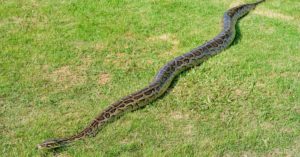One of the South’s true natural beauties is Caddo Lake, whose signature 300-year-old cypress trees make it appear like a bayou. In addition, it is the state’s only natural lake and the second biggest in the south. People flock to this lake to enjoy recreational activities like fishing, kayaking, and canoeing. However, Caddo Lake is home to some deadly predators, alligators. Therefore, visitors should always be vigilant when on the banks or the water. But just how many alligators live in Caddo Lake in Texas? Continue reading to find out.
Overview: The Alligator
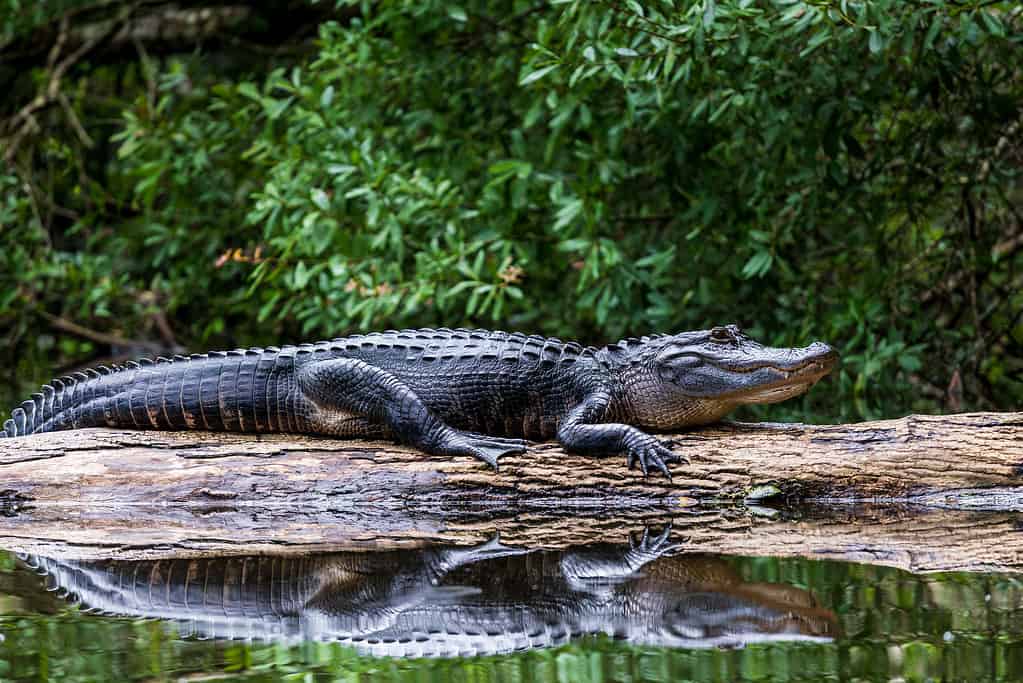
Alligators in Texas are large, armored, semi-aquatic reptiles closely related to crocodiles. They measure between 6 to 14 feet long and appear almost black in color.
©Joe Pearl Photography/iStock via Getty Images
The alligator was formerly an endangered species in the Lone Star State. However, they are now a protected game animal in Texas.
What Do Alligators Look Like?
Alligators in Texas are large, armored, semi-aquatic reptiles closely related to crocodiles. They measure between 6 to 14 feet long and appear almost black in color. In addition, they have coarse scales covering their entire bodies with prominent eyes and nostrils. Furthermore, they have large heads with visible teeth along the upper jaw. Alligators have five toes on each front foot and four webbed toes on their rear feet.
How Big Do Alligators Get?
The largest alligator on Texas records was harvested in 1998. It weighed a whopping 900 pounds and measured 14 feet and 4 inches. However, most alligators in the state barely reach 10 feet. In fact, they measure between five to six feet long on average and weigh between 25 to 50 pounds.
What Do Alligators Eat?
Juvenile alligators in Caddo Lake eat shrimp, insects, spiders, crayfish, crabs, and minnows. However, as they get older, their diet changes to small turtles, fish, frogs, small birds, and snakes. Once they reach four feet or longer, they have the luxury of becoming opportunistic hunters with a wide variety of options. For example, carrion, ducks, raccoons, large turtles, wading birds, fish, muskrats, otters, nutria, other alligators, and sometimes, deer.
Where Do Alligators Live?
Alligators in Texas range from the Sabine River of East Texas to the Gulf of Mexico to the Rio Grande across the coastal marshes. As a result, these dangerous reptiles occur in 120 counties in East Texas and the Gulf Coastal Plains. They are common in rivers, bayous, swamps, and marshes. While they primarily occur in freshwater, alligators can also tolerate brackish water.
How Many Alligators are in Caddo Lake, Texas?
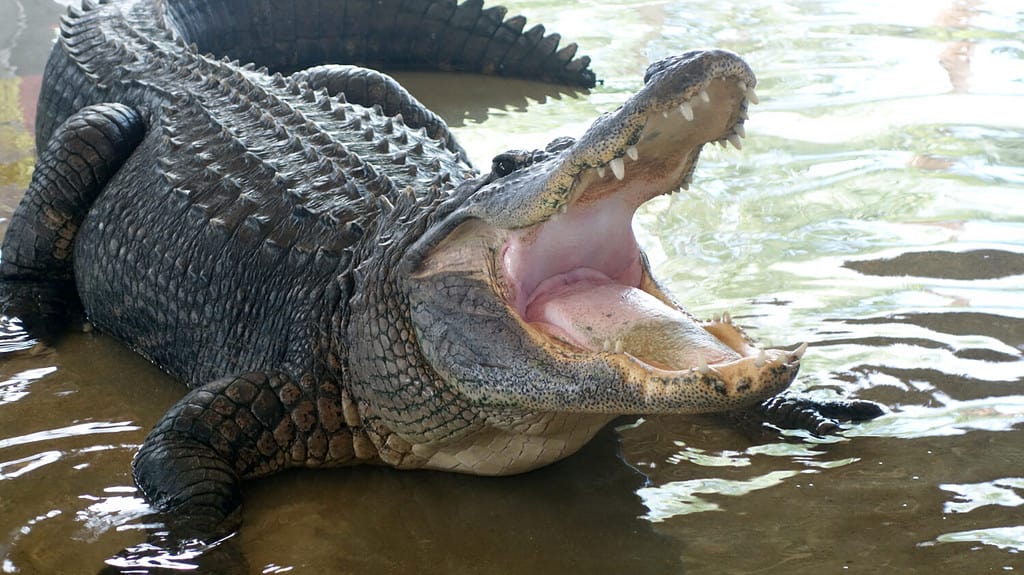
These massive reptiles like to inhabit Caddo Lake because of its abundance of cypress trees, ponds, vast bayous, creeks, and canals.
©Ernie Hounshell/Shutterstock.com
While there are between 400,000 to 500,000 alligators in the Lone Star State, estimates on the gator population in Caddo Lake are non-existent. The lake is known for its large alligator population and the size of the gators, many reaching 10 feet long. These massive reptiles like to inhabit Caddo Lake because of its abundance of cypress trees, ponds, vast bayous, creeks, and canals. The lake covers 25,400 acres, providing plenty of space for its large population. The best time to find alligators at Caddo Lake is during the summer.
Which Other East Texas Lakes Have Alligators?
While Caddo Lake might have the largest population of alligators in East Texas, there are several other lakes in the area where you can find gators, including:
Lake Hawkins
This lake sits roughly 100 miles east of the Dallas Fort Worth metroplex in a rural and thickly forested county, making it ideal for a weekend getaway. It is also very appealing because of its clear water and white sandy beaches. Lake Hawkins is home to an abundance of wildlife, including alligators, which have been spotted several times over the years. However, there are no attacks or fatalities on record for this lake.
Lake Fork
Located in Rains, Wood, and Hopkins counties, Lake Fork is a reservoir between the towns of Emory, Quitman, Yantis, and Alba. Many residents enjoy recreational activities on this lake during the summer. But alligators inhabit this area, so caution should always be taken when visiting Lake Fork.
Lake Livingstone
Lake Livingstone is one of the largest lakes in the Lone Star State. It is popular for its quiet trails through the forest and camping under its many trees. It is the ideal retreat from the hustle and bustle of the city and only an hour’s drive from Houston. Activities at this lake include swimming, boating, fishing, hiking, bird watching, camping, mountain biking, wildlife viewing, picnicking, and geocaching. However, when visiting this lake, always be weary about the alligators. There is a large population occupying Lake Livingstone, and sightings occur often.
What Other Animals Live In or Near Caddo Lake, Texas?
Caddo Lake is also home to other species that rely on it to survive, including:
Alligator Snapping Turtle

Alligator
snapping turtles
are almost completely aquatic and usually stay submerged without moving for long periods.
©iStock.com/Sista Vongjintanaruks
The alligator snapping turtle is often referred to as the dinosaur turtle because it looks so primitive. Males weigh between 155 and 175 pounds, making them the largest species of freshwater turtles. These gigantic turtles are found exclusively in the USA from Florida to eastern Texas and as far north as Iowa.
Alligator snapping turtles are almost completely aquatic and usually stay submerged without moving for long periods. For example, they stay motionless long enough for algae to grow on their shells. Furthermore, they can stay underwater for up to 50 minutes before needing to surface for air. They rarely leave the water, except for egg-laying females. These turtles usually occur in lakes, river systems, and wetlands.
Great Blue Heron
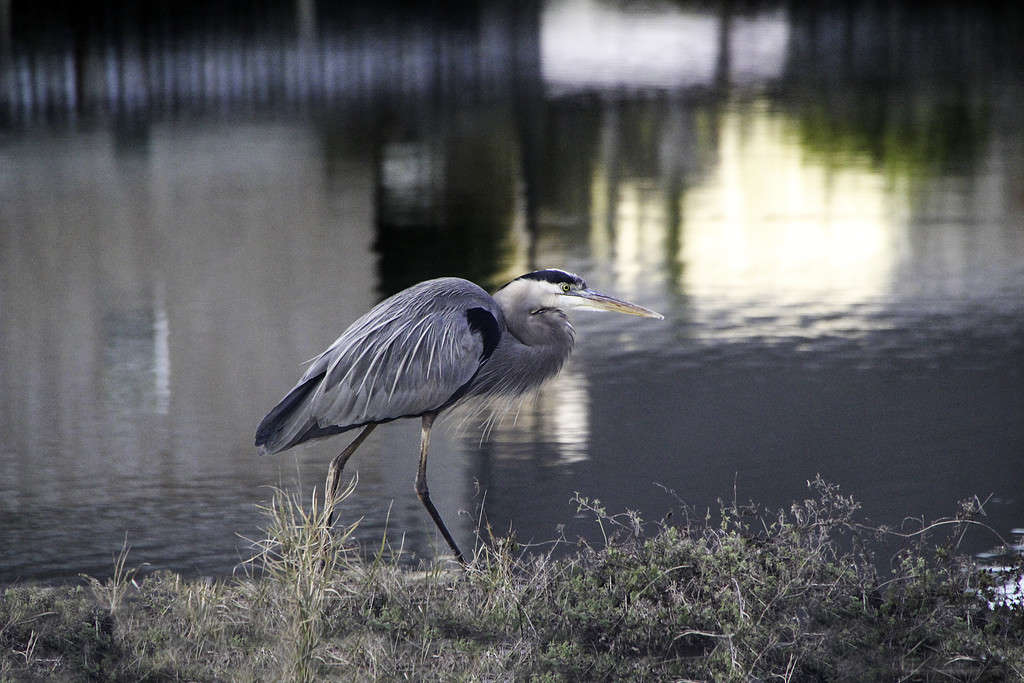
The
great blue heron
is North America’s largest heron. This massive bird measures three to four feet high and has a wingspan of nearly six feet.
©Jill Meyer Millet/ via Getty Images
The great blue heron is North America’s largest heron. This massive bird measures three to four feet high and has a wingspan of nearly six feet. Their bodies are covered in blue-gray feathers with a plume of feathers on their backs and chests. These herons breed from Canada to Mexico and the West Indies. Additionally, great blue herons winter as far north as Alaska and New England. However, they also occur on the Galapagos Islands. These birds inhabit rivers, marshes, saltwater shores, lakes, and ponds.
American Beaver
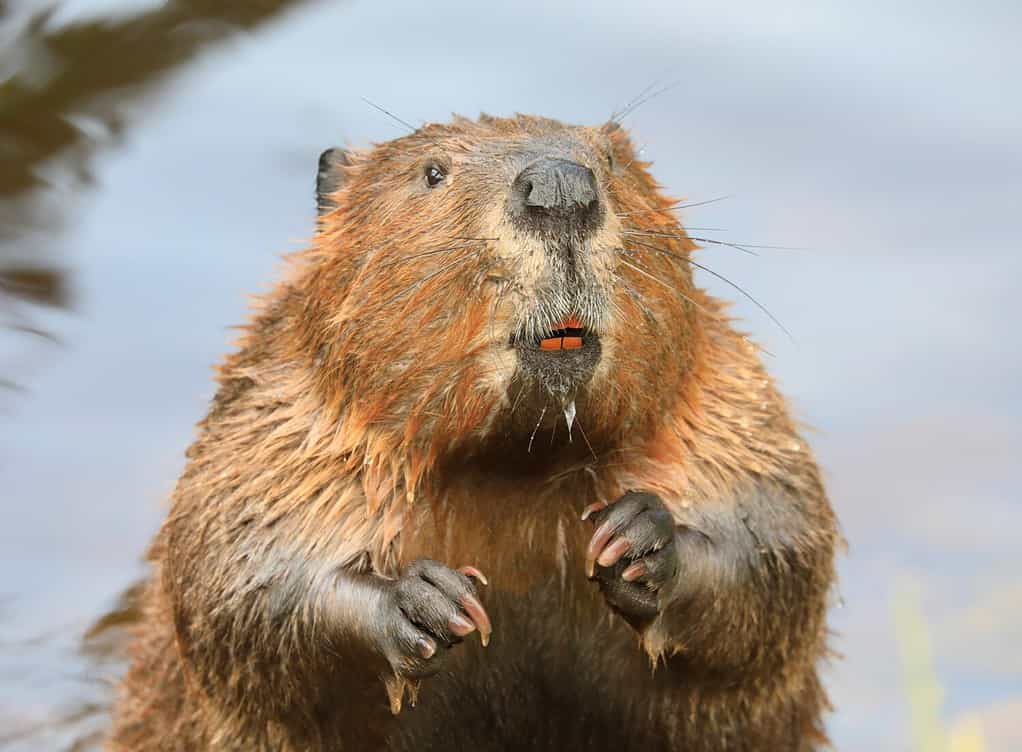
The American beaver is the largest rodent in the USA. These beavers have webbed feet and dark brown waterproof fur.
©Vlad G/Shutterstock.com
Measuring two to three feet long (excluding the tail), the American beaver is the largest rodent in the USA. These beavers have webbed feet and dark brown waterproof fur. American beavers have to gnaw on trees to keep their teeth from getting too long as they continue to grow throughout their lives. These beavers inhabit rivers, ponds, lakes, and streams throughout the continental U.S., excluding the arid areas of the Southwest. They are notorious for their amazing dam-building skills and are one of the few species that can affect the ecosystem by blocking streams and rivers with mud and trees and creating new ponds, lakes, and floodplains. Furthermore, these crafty rodents also build homes called lodges from mud and branches, which are usually accessed from submerged entrances in ponds.
Coypu
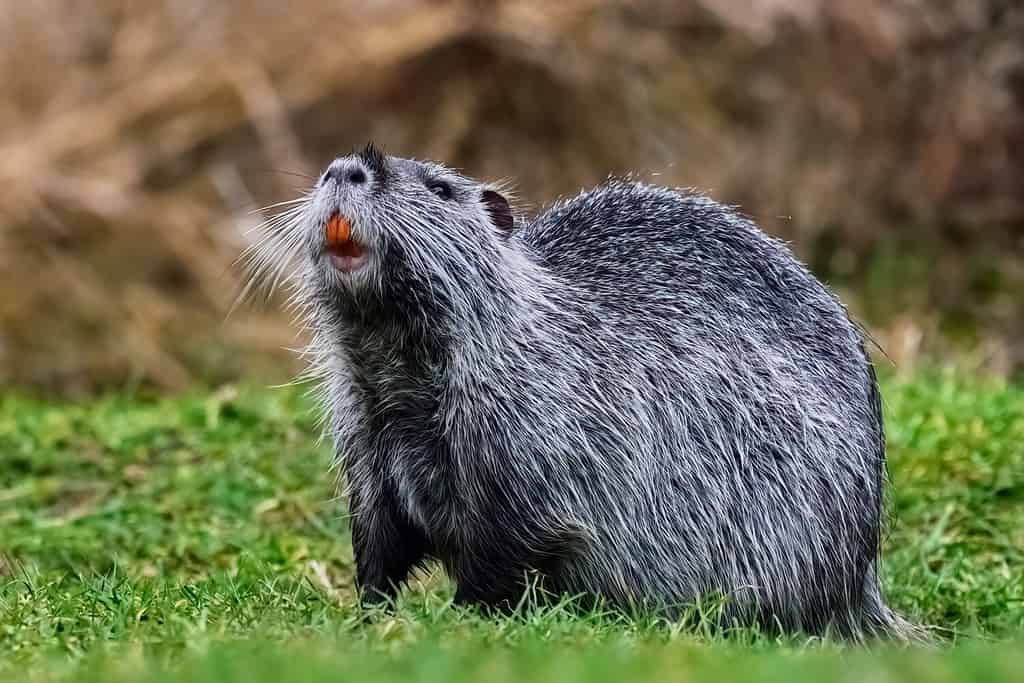
Coypus inhabit lake edges, marshes, and slow streams, particularly in areas with succulent or emergent vegetation on its banks.
©Robert Adami/Shutterstock.com
The Coypu looks like a massive rat with an arched back and a large, triangular head. In addition, they have small eyes and ears situated on the upper part of their heads. Coypus inhabit lake edges, marshes, and slow streams, particularly in areas with succulent or emergent vegetation on its banks.
The photo featured at the top of this post is © Victoria Ditkovsky/Shutterstock.com
Thank you for reading! Have some feedback for us? Contact the AZ Animals editorial team.





